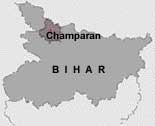


April 16, 1917. Chandrahian village, east Champaran. Moved by exploitation of indigo farmers by the planters of the British Raj, Mahatma Gandhi gives his call for satyagraha. This was arguably the first call for Independence. Gandhi also envisioned the concept of gram swaraj (village republics) from this village in east Bihar.
Today indigo is history. So are Gandhi's dreams. The district squirms with nightmarish poverty. " Yahan garibi ka kuch puchna hai kya (Do you have to ask about poverty here)?' This what the people, for whom poverty is life, here say.
Gandhi based his dreams of self-sufficiency on the agricultural potential of the district, the very factor that drew the British planters to this resource-rich region. This agricultural potential today lies wasted making the district poorer than ever.
The British, along with the zamindars (landlords), imposed the tinkathia system. Under this system, farmers were bound to grow indigo on three-fourth of their agricultural land holdings. As zamindars controlled most of the land, the farmers were either sharecroppers or tenants. Things became worse when landlords leased the land to the British planters.
Things have not changed since: the government now wears shoes of the British. Now, 90 per cent of the west Champaran's population are marginal and small farmers. And over 75 per cent of farmers have less than two hectares of land. In east Champaran, 94 per cent of the rural land is under agriculture. "But in most villages, at least 40 per cent of the people are landless,' says Rambabu Yadav, the village head of Chandrahian.The result: per capita cereal consumption (a benchmark for poverty) is 250 grammes per day compared to the national average of about 400 grammes.
So much for the nation's commitment to gram swaraj.
Links:
[1] http://admin.indiaenvironmentportal.org.in/feature-article/champaran-fragmented-reality
[2] http://admin.indiaenvironmentportal.org.in/category/newspaper/down-earth